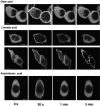Distinct effects of fatty acids on translocation of gamma- and epsilon-subspecies of protein kinase C
- PMID: 9786959
- PMCID: PMC2132830
- DOI: 10.1083/jcb.143.2.511
Distinct effects of fatty acids on translocation of gamma- and epsilon-subspecies of protein kinase C
Abstract
Effects of fatty acids on translocation of the gamma- and epsilon-subspecies of protein kinase C (PKC) in living cells were investigated using their proteins fused with green fluorescent protein (GFP). gamma-PKC-GFP and epsilon-PKC-GFP predominated in the cytoplasm, but only a small amount of gamma-PKC-GFP was found in the nucleus. Except at a high concentration of linoleic acid, all the fatty acids examined induced the translocation of gamma-PKC-GFP from the cytoplasm to the plasma membrane within 30 s with a return to the cytoplasm in 3 min, but they had no effect on gamma-PKC-GFP in the nucleus. Arachidonic and linoleic acids induced slow translocation of epsilon-PKC-GFP from the cytoplasm to the perinuclear region, whereas the other fatty acids (except for palmitic acid) induced rapid translocation to the plasma membrane. The target site of the slower translocation of epsilon-PKC-GFP by arachidonic acid was identified as the Golgi network. The critical concentration of fatty acid that induced translocation varied among the 11 fatty acids tested. In general, a higher concentration was required to induce the translocation of epsilon-PKC-GFP than that of gamma-PKC-GFP, the exceptions being tridecanoic acid, linoleic acid, and arachidonic acid. Furthermore, arachidonic acid and the diacylglycerol analogue (DiC8) had synergistic effects on the translocation of gamma-PKC-GFP. Simultaneous application of arachidonic acid (25 MicroM) and DiC8 (10 microM) elicited a slow, irreversible translocation of gamma-PKC- GFP from the cytoplasm to the plasma membrane after rapid, reversible translocation, but a single application of arachidonic acid or DiC8 at the same concentration induced no translocation. These findings confirm the involvement of fatty acids in the translocation of gamma- and epsilon-PKC, and they also indicate that each subspecies has a specific targeting mechanism that depends on the extracellular signals and that a combination of intracellular activators alters the target site of PKCs.
Figures








Similar articles
-
Subspecies-specific targeting mechanism of protein kinase C.Jpn J Pharmacol. 1998 Dec;78(4):411-7. doi: 10.1254/jjp.78.411. Jpn J Pharmacol. 1998. PMID: 9920197 Review.
-
Direct visualization of the translocation of the gamma-subspecies of protein kinase C in living cells using fusion proteins with green fluorescent protein.J Cell Biol. 1997 Dec 15;139(6):1465-76. doi: 10.1083/jcb.139.6.1465. J Cell Biol. 1997. PMID: 9396752 Free PMC article.
-
Green fluorescent protein (GFP)-tagged cysteine-rich domains from protein kinase C as fluorescent indicators for diacylglycerol signaling in living cells.J Cell Biol. 1998 Feb 9;140(3):485-98. doi: 10.1083/jcb.140.3.485. J Cell Biol. 1998. PMID: 9456311 Free PMC article.
-
Ca2+-controlled competitive diacylglycerol binding of protein kinase C isoenzymes in living cells.J Cell Biol. 2002 Oct 28;159(2):291-302. doi: 10.1083/jcb.200203048. Epub 2002 Oct 21. J Cell Biol. 2002. PMID: 12391024 Free PMC article.
-
Protein kinase C as a stress sensor.Cell Signal. 2007 Sep;19(9):1820-9. doi: 10.1016/j.cellsig.2007.05.014. Epub 2007 Jun 12. Cell Signal. 2007. PMID: 17629453 Free PMC article. Review.
Cited by
-
Immunogold electron microscopic demonstration of distinct submembranous localization of the activated gammaPKC depending on the stimulation.J Histochem Cytochem. 2008 Mar;56(3):253-65. doi: 10.1369/jhc.7A7291.2007. Epub 2007 Nov 26. J Histochem Cytochem. 2008. PMID: 18040079 Free PMC article.
-
The simultaneous production of phosphatidic acid and diacylglycerol is essential for the translocation of protein kinase Cepsilon to the plasma membrane in RBL-2H3 cells.Mol Biol Cell. 2003 Dec;14(12):4885-95. doi: 10.1091/mbc.e03-05-0295. Epub 2003 Sep 5. Mol Biol Cell. 2003. PMID: 12960426 Free PMC article.
-
Reciprocal regulation between M3 muscarinic acetylcholine receptor and protein kinase C-epsilon in ventricular myocytes during myocardial ischemia in rats.Naunyn Schmiedebergs Arch Pharmacol. 2009 Nov;380(5):443-50. doi: 10.1007/s00210-009-0444-6. Epub 2009 Aug 15. Naunyn Schmiedebergs Arch Pharmacol. 2009. PMID: 19685039
-
Bimodal role of conventional protein kinase C in insulin secretion from rat pancreatic beta cells.J Physiol. 2004 Nov 15;561(Pt 1):133-47. doi: 10.1113/jphysiol.2004.071241. Epub 2004 Sep 23. J Physiol. 2004. PMID: 15388777 Free PMC article.
-
Targeting of protein kinase C-epsilon during Fcgamma receptor-dependent phagocytosis requires the epsilonC1B domain and phospholipase C-gamma1.Mol Biol Cell. 2006 Feb;17(2):799-813. doi: 10.1091/mbc.e04-12-1100. Epub 2005 Nov 30. Mol Biol Cell. 2006. PMID: 16319178 Free PMC article.
References
-
- Akimoto K, Mizuno K, Osada S, Hirai S, Tamura S, Suzuki K, Ohno S. A new member of the third class in the protein kinase C family, PKCλ, expressed dominantly in an undifferentiated mouse embryonal carcinoma cell line and also in many tissues and cells. J Biol Chem. 1994;269:12677–12683. - PubMed
-
- Asaoka Y, Nakamura S, Yoshida K, Nishizuka Y. Protein kinase C, calcium and phospholipid degradation. Trends Biochem Sci. 1992;17:414–417. - PubMed
-
- Flower, R.J., S. Moncada, and J.R. Vane. 1985. Analgesic-antipyretics and anti-inflammatory agents. In The Pharmacological Basis of Therapeutics. A.G. Gilman, L.S. Goodman, T.W. Rall, and F. Murads, editors. Macmillan, New York. 674–715.
-
- Ganberucci A, Fulceri R, Bygrave FL, Benedetti A. Unsaturated fatty acids mobilize intracellular calcium independent of IP3 generation and VIA insertion at the plasma membrane. Biochem Biophys Res Commun. 1997;241:312–316. - PubMed
Publication types
MeSH terms
Substances
LinkOut - more resources
Full Text Sources
Research Materials

